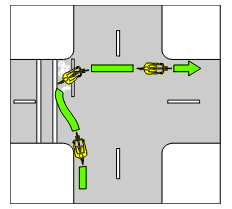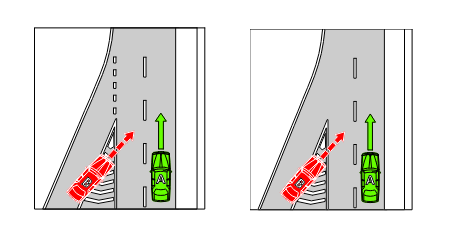Schedule 1 Model Amendments to the Australian Road Rules (6th package)
(regulation 3)
The following provisions are intended to provide the basis for nationally consistent transport laws on the topics with which they deal. They do not, of themselves, have any legal effect.
[1] After subrule 27 (1)
insert
(1A) Subrule (1) also applies to a rider of a bicycle who approaches and enters an intersection from a bicycle storage area.
Note Bicycle storage area is defined in the dictionary.
(1B) Despite subrule (1), if there is space in a bicycle storage area for 2 riders of bicycles to be next to each other, the rider on the right may approach and enter the intersection as near as practicable to the right side of the other rider, but only if that other rider approaches and enters the intersection in accordance with this rule.
[2] After subrule 28 (2), including the notes and example
insert
(2A) If there is a bicycle storage area before an intersection that extends across one or more marked lanes of a multi‑lane road, a rider of a bicycle turning left must approach and enter the intersection from within the part of the bicycle storage area that is directly in front of the left marked lane or of a bicycle lane that is on the left side of the road.
Offence provision.
Note Bicycle storage area is defined in the dictionary.
[3] After subrule 31 (4)
insert
(4A) Subrules (2), (3) and (4) also apply to a rider of a bicycle who approaches and enters an intersection from a bicycle storage area.
Note Bicycle storage area is defined in the dictionary.
(4B) Despite subrules (2), (3) and (4), if there is space in a bicycle storage area for 2 riders of bicycles to be next to each other, the rider on the left may approach and enter the intersection as near as practicable to the left side of the other rider, but only if that other rider approaches and enters the intersection in accordance with this rule.
[4] After subrule 32 (2), including the notes and example
insert
(2A) If there is a bicycle storage area before an intersection that extends across one or more marked lanes of a multi‑lane road, a rider of a bicycle turning right (but not making a hook turn) must approach and enter the intersection from within the part of the bicycle storage area that is directly in front of the right marked lane or of a bicycle lane that is on the right side of the road.
Offence provision.
Note Bicycle storage area is defined in the dictionary.
[5] After subrule 35 (3)
insert
(4) To make a hook turn under this rule at an intersection that has a bicycle hook turn storage area on the left side of the intersection as the rider approaches the intersection, the rider must take the following initial 2 steps instead of the initial 2 steps listed in subrule (3):
1 Approach the intersection from the far left side of the road the rider is leaving and enter the intersection by moving into the bicycle hook turn storage area, keeping clear of any marked foot crossing.
2 Move forward in the bicycle hook turn storage area until the rider is as near as practicable to the far side of the road that the rider is entering.
Note Bicycle hook turn storage area is defined in the dictionary.
Example

[6] Subrule 56 (1)
substitute
(1) A driver approaching or at traffic lights showing a red traffic light must stop:
(a) if there is a stop line at or near the traffic lights — as near as practicable to, but before reaching, the stop line; or
(b) if there is a stop here on red signal sign at or near the traffic lights, but no stop line — as near as practicable to, but before reaching, the sign; or
(c) if there is no stop line or stop here on red signal sign at or near the traffic lights — as near as practicable to, but before reaching, the nearest or only traffic lights;
and must not proceed past the stop line, stop here on red signal sign or nearest or only traffic lights (as the case may be) until the traffic lights show a green or flashing yellow traffic light or no traffic light.
Offence provision.
Note Red traffic light and stop line are defined in the dictionary.
[7] Subrule 56 (2), except the notes and diagrams
substitute
(2) A driver approaching or at traffic arrows showing a red traffic arrow who is turning in the direction indicated by the arrow must stop:
(a) if there is a stop line at or near the traffic arrows — as near as practicable to, but before reaching, the stop line; or
(b) if there is a stop here on red arrow sign at or near the traffic arrows, but no stop line — as near as practicable to, but before reaching, the sign; or
(c) if there is no stop line or stop here on red arrow sign at or near the traffic arrows — as near as practicable to, but before reaching, the nearest or only traffic arrows;
and must not proceed past the stop line, stop here on red arrow sign or nearest or only traffic arrows (as the case may be) until the traffic arrows show a green or flashing yellow traffic light or no traffic arrow.
Offence provision.
[8] After rule 56 (2), including the notes and diagrams
insert
(3) If there is a bicycle storage area before any traffic lights referred to in subrule (1) or (2), a reference to the stop line in subrule (1) (a) or (2) (a):
(a) in the case of a driver of a motor vehicle, is a reference to the first stop line that the driver comes, or came, to in approaching the lights;
(b) in the case of a rider of a bicycle, is a reference to the stop line that is nearest to the intersection.
Note Bicycle storage area is defined in the dictionary.
[9] After rule 57 (3), including the notes
insert
(4) If there is a bicycle storage area before any traffic lights referred to in subrule (1) or (2), a reference to the stop line in subrule (1) (a) or (2) (a):
(a) in the case of a driver of a motor vehicle, is a reference to the first stop line that the driver comes, or came, to in approaching the lights;
(b) in the case of a rider of a bicycle, is a reference to the stop line that is nearest to the intersection.
Note Bicycle storage area is defined in the dictionary.
[10] After rule 60
insert
60A Proceeding through a bicycle storage area before a red traffic light or arrow
(1) If there is a bicycle storage area before traffic lights that are showing a red traffic light, a driver of a motor vehicle must not allow any part of the vehicle to enter the bicycle storage area.
Offence provision.
Note Bicycle storage area, red traffic light, and motor vehicle are defined in the dictionary.
(2) If there is a bicycle storage area before traffic arrows that are showing a red traffic arrow, and a driver of a motor vehicle is turning in the direction indicated by the arrow, the driver must not allow any part of the vehicle to enter the bicycle storage area.
Offence provision.
Note Red traffic arrow is defined in the dictionary.
[11] At the end of rule 92
insert
(3) The existence of a bicycle storage area in a marked lane does not alter a driver’s obligation to comply with this rule.
Note Bicycle storage area is defined in the dictionary.
[12] After note 2 in subrule 138 (2)
insert
Note 3 Subrule (3) excludes certain painted islands from the application of paragraph (a).
[13] At the end of rule 138
insert
(3) Subrule (2)(a) does not apply in the case of a painted island:
(a) that separates a road that takes vehicles in one direction from another road that takes vehicles in the same direction at a place where the roads merge; or
(b) that separates one part of a road from other parts of the road to create a slip lane.
Note Slip lane is defined in the dictionary.
Example 1 Example 2

[14] After rule 247
insert
247A Entering a bicycle storage area
(1) A rider of a bicycle approaching a bicycle storage area at an intersection that has traffic lights or traffic arrows showing a red traffic light or red arrow must not enter the bicycle storage area other than from a bicycle lane, unless the rider is not required to ride in the bicycle lane under the Australian Road Rules.
Offence provision.
Note Bicycle storage area is defined in the dictionary.
(2) Subrule (1) does not apply if:
(a) the bicycle storage area cannot, under another law of this jurisdiction, be entered from a bicycle lane; and
(b) the rider enters the area in accordance with another law of this jurisdiction.
247B Giving way while entering or in a bicycle storage area
(1) A rider of a bicycle must when entering a bicycle storage area, give way to:
(a) any vehicle that is in the area; and
(b) if the area is before any green or yellow traffic lights, any motor vehicle that is entering or about to enter the area, unless the motor vehicle is turning in a direction that is subject to a red traffic arrow; and
(c) if the area forms part of a lane to which traffic arrows apply, any motor vehicle that is entering or about to enter the area at a time when those arrows are green or yellow.
Offence provision.
Note Bicycle storage area is defined in the dictionary.
(2) A rider of a bicycle that is in a bicycle storage area that extends across more than one lane of a multi‑lane road must, if the area is before any green or yellow traffic lights, give way to a motor vehicle that is in any lane other than the lane that the bicycle is directly in front of, unless the motor vehicle is turning in a direction that is subject to a red traffic arrow.
Offence provision.
[15] Schedule 3, after Hand‑held stop sign, last occurring
insert
Hand‑held stop sign (rules 80, 101) 
|
[16] Dictionary, after the definition of bicycle
insert
bicycle hook turn storage area means an area between an intersection and a marked foot crossing, or if there is no marked foot crossing, a stop line, before the intersection that has painted on it one or more bicycle symbols and one or more right traffic lane arrows, and includes any line that delineates the right side of the area, and any line that delineates the left side of the area that is not also a stop line or part of a marked foot crossing and excludes any bicycle storage area.
Note 1 Intersection, bicycle symbol, right traffic lane arrows, motor vehicle and marked foot crossing are defined in this dictionary and hook turns are described in rules 34 and 35.
Note 2 see example in rule 35.
bicycle storage area means:
(a) an area of a road before an intersection with traffic lights:
(i) that has painted on it one or more bicycle symbols; and
(ii) that is between two parallel stop lines, regardless of whether the lines are of equal length; and
(iii) that opens out from a bicycle lane;
but does not include any stop line; or
(b) if another law of this jurisdiction defines a bicycle storage area, that area as defined under that law.
Note Intersection, traffic lights, bicycle symbol and stop line are defined in this dictionary.
[17] Dictionary, definition of painted island
substitute
painted island means an area of a road:
(a) that has painted on it stripes or chevrons in white or another colour that contrasts with the colour of the road; and
(b) that is surrounded either:
(i) by a line or lines (whether broken or continuous); or
(ii) partly by a combination of a line or lines (whether broken or continuous) and partly by a kerb or by a structure on or next to the road.
[18] Dictionary, paragraph (b) of the definition of stop line
substitute
(b) is not part of a marked foot crossing, a keep clear marking or a bicycle storage area for hook turns.



